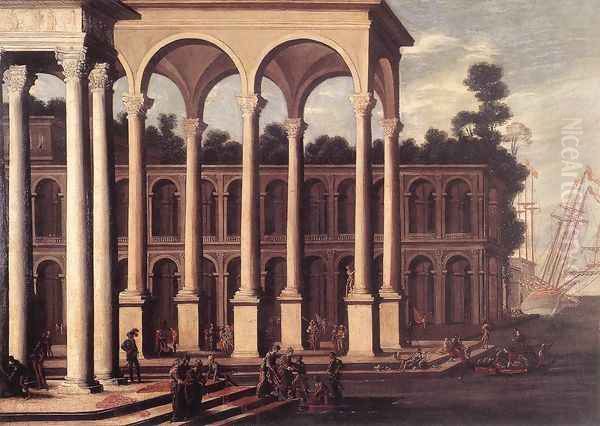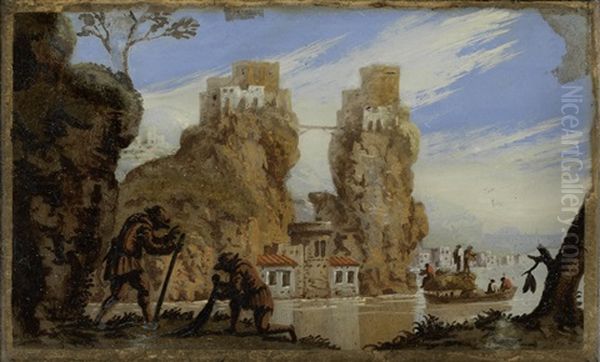Agostino Tassi stands as a significant yet controversial figure in the landscape of Italian Baroque art. Active primarily in Rome and Florence during the late 16th and early 17th centuries, Tassi carved a niche for himself as a master of illusionistic fresco painting, particularly architectural perspectives known as quadratura, and as a highly regarded painter of landscapes and seascapes. His artistic achievements, however, are often overshadowed by his turbulent personal life, most notoriously his conviction for the rape of the celebrated painter Artemisia Gentileschi. Despite this infamy, Tassi's influence on the development of landscape painting, notably through his tutelage of Claude Lorrain, secures his place in art history. His life and work offer a compelling glimpse into the vibrant, competitive, and sometimes brutal art world of Baroque Italy.
Origins and Artistic Formation
The precise details of Agostino Tassi's early life remain somewhat debated among historians. While later in life he claimed Roman birth, evidence suggests he was actually born Agostino Buonamici in Perugia around 1578. Some earlier sources proposed birth years like 1566 or 1575, but scholarly consensus leans towards the later date. His family background was modest; they were reportedly furriers. The adoption of the surname "Tassi" is said to have occurred later, possibly through adoption by the Marchese Tassi, although this story might have been a fabrication by the artist himself to enhance his social standing – a common practice in an era where lineage could significantly impact patronage.
His early artistic training is not well documented, but it is known that he spent time working in Florence between 1594 and potentially as late as 1610, with periods possibly spent in Livorno as well. In Florence, he likely absorbed the principles of late Mannerist decoration and perspective techniques. His work in Livorno, a bustling port city, is thought to have nurtured his skill in depicting marine subjects, ships, and coastal scenes, which would become a recurring theme in his oeuvre. It was during these formative years that he likely honed the skills in perspective and architectural rendering that would later define his career as a fresco painter.
Arrival in Rome and Rise as a Fresco Painter

Around 1610, Agostino Tassi settled in Rome, the undisputed center of the European art world. The city was teeming with artistic innovation, driven by the legacy of High Renaissance masters and the revolutionary naturalism of Caravaggio, alongside the burgeoning Baroque style. Tassi arrived at a time when large-scale fresco decoration for palaces and churches was in high demand among the Roman aristocracy and clergy. His specialized skill in quadratura – the painting of illusionistic architectural frameworks that appeared to extend the real architecture of a room – made him a valuable asset.
In Rome, Tassi quickly integrated into the artistic milieu. He was particularly influenced by the Northern European landscape painters active in the city, most notably the Flemish artist Paul Bril and his brother Matthijs Bril. Their detailed observation of nature and atmospheric effects resonated with Tassi. Another significant influence was the German painter Adam Elsheimer, whose small, poetic landscapes with innovative light effects were highly admired. Tassi adapted these influences, combining Northern detail with an Italianate sense of structure and dramatic composition, creating expansive, often fantastical, architectural and landscape vistas.
Major Fresco Commissions: The Art of Illusion
Tassi's reputation as a specialist in perspective and illusionistic painting led to several prestigious commissions in Roman palaces. One of his earliest significant projects was likely work within the Quirinal Palace, the papal summer residence. His ability to create convincing trompe-l'oeil architectural settings provided sophisticated backdrops for narrative scenes often executed by figure painters. This collaborative model was common, with specialists like Tassi providing the settings for artists more adept at human figures.
Perhaps his most famous fresco cycles were executed in the Palazzo Pallavicini-Rospigliosi, specifically in the Casino delle Muse. Here, between approximately 1611 and 1612, Tassi collaborated with Orazio Gentileschi. Tassi painted the elaborate architectural framework and landscape elements, while Gentileschi provided the figures of the Muses. This project showcased Tassi's mastery of creating airy loggias and expansive views that seemed to open up the walls of the room. Some scholars suggest other artists, possibly including Guercino later, might have contributed figures to different parts of the Rospigliosi decorations Tassi worked on.

Another major undertaking was the decoration of rooms in the Palazzo Lancellotti ai Coronari around 1617-1623. Here, Tassi created complex illusionistic schemes, including painted ceilings with views opening to the sky (sfondato) and walls adorned with fictive architecture, landscapes, and seascapes. These works solidified his reputation as one of Rome's leading decorative painters, sought after for his ability to transform interior spaces with dazzling visual effects. His work can be seen in the context of other great decorators of the era, such as Annibale Carracci at the Palazzo Farnese or Domenichino, though Tassi specialized more purely in the landscape and architectural elements.
A Shadow Over Fame: The Gentileschi Trial
Tassi's rising fame was irrevocably tainted by his personal conduct. In 1611, while collaborating with Orazio Gentileschi on the Palazzo Rospigliosi project, Tassi was also engaged by Orazio to teach perspective drawing to his talented daughter, Artemisia Gentileschi. During one of these lessons, Tassi raped Artemisia in her home. Following the assault, Tassi promised marriage to restore her honor (a common, though often unfulfilled, resolution in such cases at the time) but repeatedly delayed, possibly because he was already married.
In 1612, Orazio Gentileschi formally accused Tassi of the rape of Artemisia. The subsequent trial lasted seven months and became a public scandal in Rome. The court records provide harrowing details of the proceedings. Artemisia bravely testified against Tassi, enduring humiliating gynecological examinations and judicial torture (the sibille, thumbscrews) intended to verify her testimony. Tassi, who already had a criminal record involving accusations of arranging his wife's murder, incest with his sister-in-law, and assault, mounted a defense that included character assassination against Artemisia.
Despite Tassi being found guilty, his sentence was remarkably lenient: a five-year exile from Rome. Crucially, this sentence was never enforced, likely due to the protection Tassi enjoyed from powerful patrons, potentially including Pope Paul V himself. The trial had a profound impact on Artemisia Gentileschi, who left Rome shortly after and channeled her experiences into powerful paintings featuring strong, often vengeful, female protagonists. For Tassi, while the conviction damaged his reputation, it did not end his career, highlighting the gender inequalities and power dynamics prevalent in 17th-century society and its justice system.
Master of Land and Sea: Easel Paintings
Beyond his extensive work as a fresco painter, Agostino Tassi was also a prolific producer of easel paintings, primarily landscapes and seascapes. These works allowed him to explore themes and compositions independent of architectural constraints. His landscapes often feature classical ruins, pastoral scenes, or dramatic coastal views, reflecting the influence of Paul Bril but developing a more fluid and atmospheric style. He frequently incorporated mythological or biblical narratives into his landscapes, though the figures are often subordinate to the expansive natural setting.
His seascapes were particularly admired. He depicted harbors bustling with activity, ships navigating calm waters, and dramatic shipwrecks tossed by stormy seas. These marine paintings demonstrate his keen observation of maritime life, likely stemming from his time in Livorno, combined with a Baroque taste for drama and movement. Works like his Coastal Landscape with the Calling of Saint Peter or various depictions of naval battles showcase his ability to render water, sky, and vessels with convincing detail and atmospheric effect.
A notable example of his easel work is the Landscape with a Scene of Witchcraft, now in the Walters Art Museum, Baltimore. This painting exemplifies his interest in dramatic and somewhat fantastical subjects, set within a meticulously rendered landscape under evocative lighting. It shows his ability to blend naturalistic observation with imaginative elements, a characteristic found in much of Baroque landscape painting. His approach can be compared to other landscape specialists active in Rome, such as his contemporary Filippo Napoletano, who also favored coastal scenes and dramatic events.
Teaching and Influence: Shaping the Next Generation
Agostino Tassi's most significant contribution to the history of art may lie in his role as a teacher. His most famous pupil was the French artist Claude Gellée, known as Claude Lorrain, who would become one of the greatest landscape painters of all time. Claude studied with Tassi in Rome, likely between 1622 and 1625. From Tassi, Claude learned the fundamentals of perspective, landscape composition, and techniques for rendering atmospheric light and architectural elements within natural settings. While Claude would ultimately develop his own unique, idealized style, Tassi's instruction provided a crucial foundation.
Tassi may have shared teaching duties for Claude with Goffredo Wals, another landscape painter active in Italy, highlighting the network of landscape specialists working and teaching in Rome. Tassi's influence can also be seen, albeit perhaps less directly, on later painters specializing in architectural views (vedute) and perspective scenes, such as Viviano Codazzi. Although Tassi's personal reputation was tarnished, his technical skill, particularly in perspective and the integration of architecture and landscape, remained influential.
While Tassi operated within the broader context of Roman Baroque art, his focus set him apart from the dominant trends represented by figures like Caravaggio, with his intense realism and dramatic chiaroscuro focused on the human figure, or the High Baroque sculptor and architect Gian Lorenzo Bernini. Tassi's career ran parallel to other major painters like Guido Reni, Domenichino, and Giovanni Lanfranco, who excelled in large-scale figurative compositions, but Tassi's primary contribution remained in the realms of illusionistic decoration and the evolving genre of landscape painting.
Later Years and Final Works
Despite the scandal of the 1612 trial, Agostino Tassi continued to receive commissions and maintain a successful career in Rome. The lack of enforcement of his exile sentence allowed him to remain active in the city's art scene. He continued to undertake fresco projects for Roman palaces and churches, although documentation for his later works is sometimes less complete than for his earlier, more famous commissions. He also continued producing easel paintings, refining his landscape and seascape formulas.
His style remained relatively consistent, characterized by skillful perspective, atmospheric depth, and often dramatic compositions featuring architectural elements or coastal scenery. He remained a respected, if perhaps notorious, figure in Roman artistic circles until his death. Agostino Tassi died in Rome in 1644, leaving behind a substantial body of work that significantly contributed to the decorative arts and landscape painting traditions of the Baroque era.
Conclusion: A Complex Legacy
Agostino Tassi's legacy is undeniably complex. As an artist, he was a highly skilled and innovative painter, particularly renowned for his mastery of quadratura and illusionistic fresco decoration. His work transformed the interiors of Roman palaces, creating dazzling vistas that merged architecture and landscape. He was also a significant figure in the development of Baroque landscape and seascape painting, contributing numerous easel works and, crucially, providing foundational training for Claude Lorrain, a future giant of the genre. His collaborations with artists like Orazio Gentileschi place him firmly within the network of major figures in early 17th-century Roman art.
However, Tassi's artistic achievements cannot be separated from his reprehensible personal actions, most notably the rape of Artemisia Gentileschi and the subsequent trial. This event casts a long shadow over his biography and forces a confrontation with the often-uncomfortable relationship between artistic genius and personal morality. He remains a figure remembered as much for his crime as for his canvases. Ultimately, Agostino Tassi embodies the multifaceted nature of the Baroque era – a period of immense artistic creativity and innovation, yet also one marked by social hierarchies, power imbalances, and profound human failings. His work merits study for its technical brilliance and historical importance, while his life serves as a sobering reminder of the darker currents running beneath the surface of artistic patronage and production in Baroque Rome.